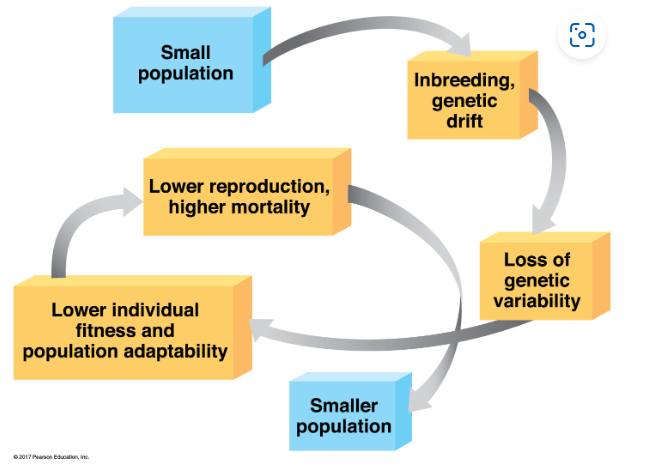BIOL 1040 - Conservation
1/27
Earn XP
Description and Tags
BIOL 1040 (General Biology II); Exam 4
Name | Mastery | Learn | Test | Matching | Spaced |
|---|
No study sessions yet.
28 Terms
Conservation Biology
Integrative discipline that strives to conserve biological diversity. Often focuses on either small and vulnerable populations or on populations that are declining rapidly. The ultimate goal is to avoid extinction.
Genetic Diversity
Genetic variation within a population and genetic variation between populations.
Species Diversity
Focuses on the number of species in an ecosystem. Species may be endangered (threat of extinction throughout its range) or threatened (likely to become endangered).
Ecosystem Diversity
Maintaining ecosystems that allow species to thrive.
Benefits of Biodiversity
The truly selfish look at biodiversity often centers around what biodiversity may provide to humans in terms of food, medicine, shelter, and products. There is a broader movement that looks at the intrinsic value of all forms of life.
Ecosystem Services
This focuses on the processes that natural ecosystems provide to help sustain human life. And includes things like water, pollination of crops, soil enrichment, etc.
Threats to Biodiversity
Habitat Loss, Introduced Species, Overharvesting, Global Change
Habitat Loss
Human alteration of habitat is the single greatest threat to biodiversity. Habitat destruction, habitat fragmentation, and habitat alteration are all global issues.
Introduced Species
Humans move other species around the globe with them and to address issues. However, these species often have no competition and take over the native species. Kudzu in the south was brought in for erosion control and is now ubiquitous in the southern landscape.
Overharvesting
Humans are a consumptive species. We often take more of a wild species that is necessary for sustenance (with lots of waste). This leads to _____________ and a loss of species. South Carolina’s shrimping industry is a prime example.
Global Change
This is an alteration of global patterns in weather, greenhouse effects, acid rain, etc. that are directly attributable to human activities like the burning of fossil fuels, industrial waste, depletion of ozone, etc. Environmental regulations have turned this somewhat from what we saw in the 1980s but deregulation threatens the advances that have been made.
Population Conservation
There are two approaches. Focus on small populations or focus on declining populations to prevent them from becoming small populations.
Small Population Approach
Small populations are vulnerable to human activity; therefore, there is need to protect them. However, how do we decide which populations? Pretty much everyone can get behind saving a Rhino population, but will a beetle population garner the same interest?

Small Populations drive extinction vortexes, where there comes a point when the population becomes smaller and smaller.
Minimum Viable Population Size
This looks at the size of the population that begins to be affected by the extinction vortex. This is the minimum size in which a population can sustain its numbers. Many conservation biologists look to models to help determine this number for a given species.
Effective Population Size
This look not just at the number of individuals in a species but at its breeding potential. Again, modeling helps scientists understand the EPP of a species.
Declining Population Approach
This focuses on species that are showing a downward trend. This approach looks more closely at what factors are causing the decline. The ultimate goal is to stop the decline.
Conflicting Demands
This often takes into account the costs and benefits of saving a species. For instance, a road needs to be built for human use but it runs through the habitat of an endangered salamander. How do you balance the costs and benefits of the competing needs? What is the ecological role of the species? Is it a Keystone species? How might this change an entire ecosystem?
Fragmentation and Edges
Edges between ecosystems have their own characteristics separate for the ecosystems on either side of it. As ecosystems become more fragmented, they have more edges. Edge ecologies can give insight into preservation or potential destruction of ecosystems.
Corridors
These are attempts to connect ecosystems for movement of organisms in places that have been disrupted by humans. Natural corridors also exist as through mountains or across rivers.
Biodiversity Hotspots
Relatively small areas with rich species diversity
Nature Reserves
These are considered to be “islands” of biodiversity in an overall area of altered habitat. This may be a small tract of land in a housing development, or a large tract of land in a state or region.
Zoned Reserves
These are extensive regions that are relatively undisturbed and surrounded by human activity. We have taken this approach in the US with marine sanctuaries and some of our national parks
Urban Ecology
Looks at organisms and their environment in urban settings. A large focus is on urban streams. We see this happening with the Reedy River in Greenville. Once polluted and frankly disgusting, this is now a central part of the Greenville landscape and is being cleaned, protected, and seen as a central resource. The maintenance of Central Park in NYC is another massive approach to urban ecology.
Nutrient Enrichment
Byproduct of our quest to grow more food on less land in shorter periods of time. This results in runoff of the fertilizers that we place in soils. This enters river systems and ultimately ends up in larger bodies of water with significant effects.
Environmental Toxins
These are often by-products of human activity and industry. The diagram below shows some human activities, including daily life and agriculture, that ultimately release toxins into the environment.
Greenhouse Gasses
The release of __________ _________ from burning fossil fuels and deforestation have greatly increased carbon dioxide levels in the atmosphere. Creating the greenhouse effect that insulates the planet and ultimately raises the overall temperature. This shifts global climate patterns and results in climate change.
Depletion of Ozone
This allows more sunlight to reach the earth’s surface by loss of protective ozone. The combination of this with green house gasses exacerbates the greenhouse effect on the planet and climate change.